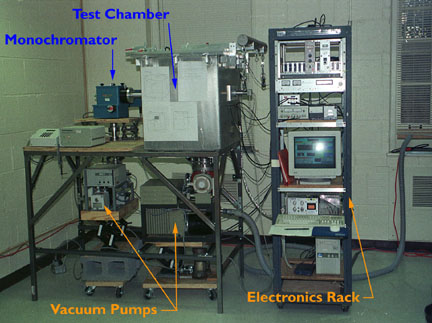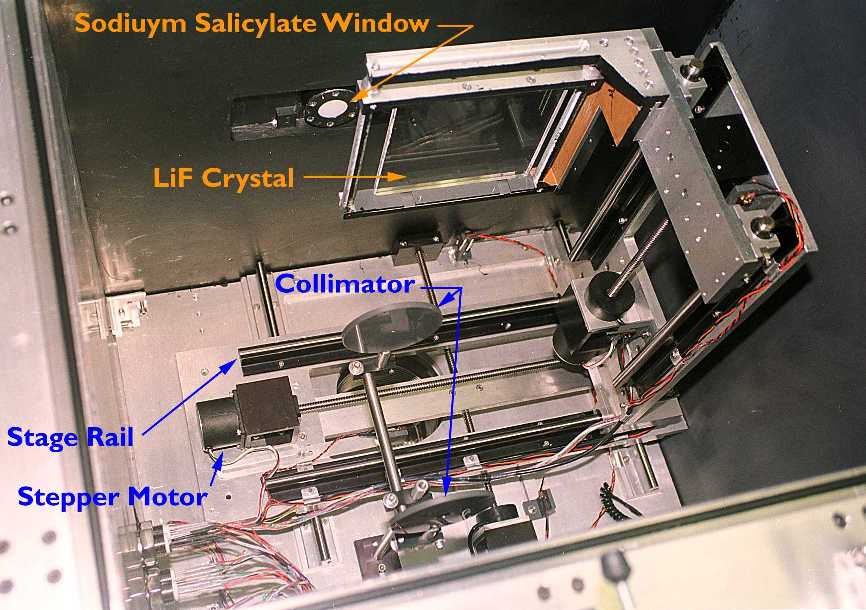The SMU VUV Spectrophotometer

Introduction
The SMU High Energy Physics group designed and built a special
purpose, computer controlled spectrophotometer. This precision device
measures the clarity of the LiF radiator crystals in the ring imaging
Cherenkov detector of the CLEO experiment at the Cornell electron
storage ring (CESR). It operates principally in the vacuum ultraviolet
(VUV) portion of the electromagnetic spectrum and is capable of
producing working wavelengths down to 121 nanometers. A photograph of
the entire device is shown below.

Monochromator
The VUV light used to probe the clarity of the LiF crystals is
produced by the blue monochromator seen on the left hand side of the
photograph. The probe light has a typical wavelength of 150
nanometers, approximately 1/3 the size of visible light. To produce
this light, heated deuterium gas contained in a glass envelope shines
into the monochromator and onto a diffraction grating. Adjusting the
orientation of the grating with respect to he deuterium lamp selects
light of a precise wavelength which then exits the output port of the
monochromator and travels along the horizontal aluminum tube that
joins the monochromator with the test chamber.
Test Chamber
A view from above and looking down into the test chamber is shown
below. A LiF crystal is installed in a frame which in turn is
attached to a robotic stage. Stage motion allows all of the crystal
surface area to be exposed to the VUV light from the monochromator. A
stepper motor and one of the rails for one of the stage axes are
indicated in the photograph. The VUV light enters the chamber at the
bottom of the photograph and is collimated before it strikes the
crystal. Light transmitted through the crystal then strikes the white
disk at the far side of the box. This disk is a sodium salicylate
window which converts the transmitted VUV light to visible light,
allowing its subsequent detection by a photomultiplier tube (PMT), a
device that converts light into electricity. A PMT is located just
behind the window and can be seen in the first photograph, on the
right hand side of the chamber and opposite the input tube from the
monochromator.

Vacuum Pumps
The VUV light produced by the monochromator and used to probe the
clarity of the LiF crystals is strongly absorbed by air. To minimize
this absorption so that the measuring technique is practical, vacuum
pumps are used to exhaust the air from both the monochromator and the
test chamber. The pressure inside the monochromator is about 3 x 10-7
torr (400 trillionths of the normal atmospheric pressure at sea level)
while the pressure in the chamber during a normal operation is larger,
typically 4 x 10-4 torr (500 billionths of the normal atmospheric
pressure at sea level).
Electronics Rack
Various electronic devices are used to control operations related to
stage movement and data acquisition. For example, the wavelength of
the light from the monochromator must be selected, the voltage on the
PMT must be set, the stage stepper motors must be controlled so that
the crystal is moved appropriately, and the electrical signal from the
PMT must be amplified and digitized all before the clarity of a LiF
crystal can be determined. The electronic devices are controlled by
software that runs on a PC so that the entire clarity measurement is
automatic. The automatization is necessary since over 500,000
measurements are required to test the clarity of the full set of LiF
crystals. The software that controls the spectrophotometer also
computes and displays the results of the clarity measurement as the
measurement proceeds. In addition, useful diagnostic information such
as test chamber pressure and PMT voltage is also displayed.
This work was
supported by the Department of Energy and the National Science
Foundation.
T.E. Coan
<coan@mail.physics.smu.edu>

![]()


